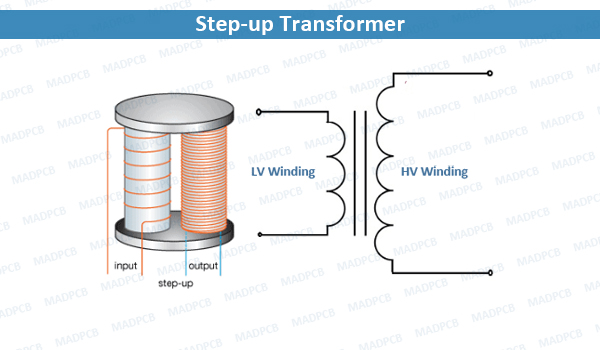What’s A Step-up Transformer?
A Step-up Transformer is a type of transformer that converts the low voltage (LV) and high current from the primary side of the transformer to the high voltage (HV) and low current value on the secondary side of the transformer. The reverse of this is known as a Step-down Transformer.
A transformer is a piece of static electrical equipment which transforms electrical energy (from primary side windings) to the magnetic energy (in the transformer’s magnetic core) and again to the electrical energy (on the secondary transformer side). A step-up transformer has a wide variety of applications in electrical systems and transmission lines.
The operating frequency and nominal power are approximately equal on the primary and secondary transformer sides because the transformer is a very efficient piece of equipment – while the voltage and current values are usually different.
A transformer provides galvanic isolation in the electrical system. Due to these two main features, the transformer is the most important part of the electrical system and provides economical and reliable transmission and distribution of electrical energy.
The transformer can transfer energy in both directions, from HV to LV side as well as inversely. That is the reason why it can work as a voltage step-up or step-down transformer. Both transformer types have the same design and construction.
Theoretically, we can operate any transformer as a step-up as well as a step-down type. It only depends on the energy flowing direction.
The HV windings contain a huge number of turns compared with the LV windings. An LV winding wire has a bigger cross-section than HV wire because of the higher current value on the LV side. Usually, we place the LV windings close to the transformer core, and over them, we wound the HV windings.
The transformer turns ratio (n) for a step-up transformer is approximately proportional to the voltage ratio:
N = VP/VS=NP/NS
Where VP, VS are voltages, and NP and NS are the turns numbers on the primary (LV) and secondary (HV) sides respectively. The primary side of a step-up transformer (LV side) has a smaller number of turns than the secondary side (HV side).
That means energy flows from the LV to the HV side. The voltage is stepped up from the primary voltage (input voltage) to the secondary voltage (output voltage).
This equation can be rearranged for the formula for the output voltage (i.e. secondary voltage). This is sometimes referred to as the step-up transformer formula:
Vs=(NS*VP)/NP
A transformer calculator can help you easily calculate the transformer turns ratio and whether the device is a step-up or step-down transformer.
The most important application of a step-up transformer is a generator step-up (GSU) transformer used in all generating plants.
Those transformers usually have large turns ratio values. The voltage value produced in energy generation is increased and prepared for the long-distance energy transmission.
The energy produced in generating plant is at low voltage and high current values. Depending on the generating plant type, the GSU transformer has a nominal primary voltage value from 6 up to 20 kV.
The nominal voltage value of the GSU secondary side can be 110 kV, 220 kV, 410 kV depending on energy transmission system connected to the GSU secondary side. The current value on the primary GSU side is usually very high and depending on the nominal transformer power can reach even 30000 A.
This current value is not practical for energy transmission and has to decrease because of the transmission power losses (R × I2). Long-distance energy transmission would not be possible. Besides the GSU transformer also makes galvanic isolation between the generator and electrical network.
Step-Up Transformer Applications
A small step-up transformer can be used in electronic and electrical devices where the voltage boosting is required. But nowadays in modern electronic devices, power electronic circuits are more frequently used because of smaller weight and dimension.
A giant power step-up transformer is used for stepping up the generated power to a higher voltage level for the efficient transmission of electricity.

